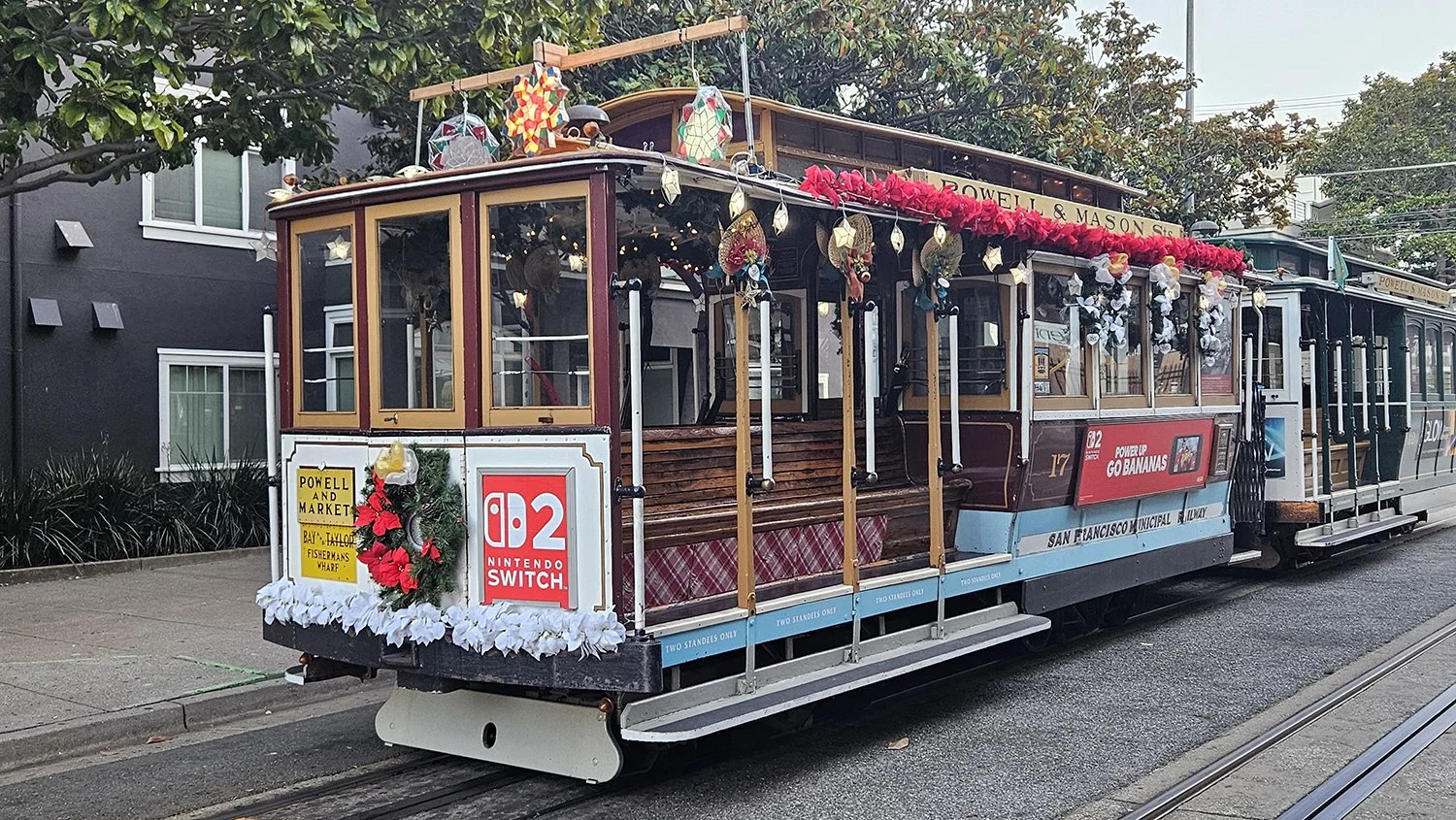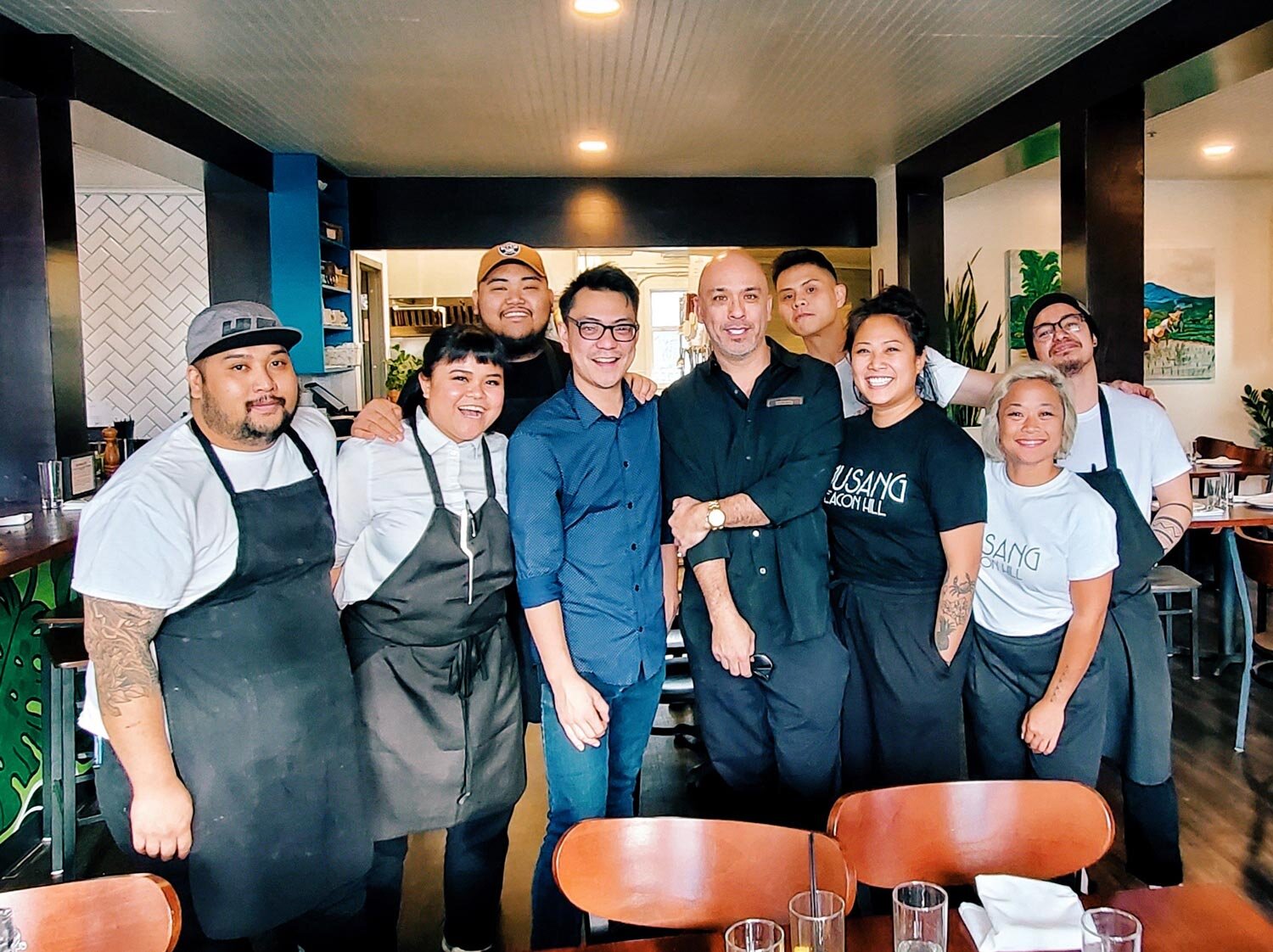Where Good Food Declares ‘We’ve Arrived!’
/Chef Melissa Miranda (third from right) and the crew of Musang take a picture with Fil-Am comedian Jo Koy (fifth from the left) (Photo courtesy of Musang)
The extreme of one opinion is reflected by the stereotype of immigrant baby boomers with an Old World obsession with their pocket books that explains their stubborn resistance to dining at a nice restaurant like Musang whose dinuguan costs triple the price of a Big Mac. On the other end of the spectrum is their stereotypical offspring — millennial hipsters who are proud to pay more for alternative takes on familiar dishes containing novel substitutes for the scabrous bottles of soy sauce and vinegar in their parents’ kitchens. The brand loyalty of trend followers may only last until Maldivian cuisine becomes the rage.
For better or worse, Filipino food has come of age during a time when food is acknowledged to be intrinsically part of political debates involving such weighty matters as the environment and land use, concentration of unhealthy calories within poor neighborhoods, and the changing landscape of race relations. Filipinos have to get beyond internal bickering to have their voice heard as a unified bloc within the wider society.
Making ‘We Are What We Eat’ the Ultimate Compliment
Filipino Americans of all adult generations comprise the majority of donors who contributed to over $90,000 in crowdfunding that helped Chef Melissa Miranda expand her popular pop-up into a sit-down restaurant in January 2020. Some supporters may turn pale in front of a plate of $16 pork sinigang, but they realize that Musang represents more than a fine-dining experience.
Musang, housed in a repurposed craftsman located on Seattle’s Beacon Hill, is the ideal forum for developing unity within the Filipino community.
“Musang is for us by us. Community driven, not chef driven. Experience and culture first with food as a supporting role,” says Chef Miranda. “People wanted Musang to exist because they were proud to see Filipino food back on Beacon Hill and also have a space to call their own.”
She elaborates on this concept of shared space: “We feel that the inclination to come to our space and experience us should be about more than just the food. It’s about the story, about who we are and our mission to make food be a vessel for gathering, sharing space, and building up our community. We hope that our visitors consider this with an open mind and see true value in supporting our business when they join us for a meal.”
Keeping the Heart of Beacon Hill Beating
For the sake of disclosure, I admit I was born in Seattle and grew up within a half mile of Musang’s address of 2524 Beacon Avenue South. Like neighboring parts of the Amazon company town, Beacon Hill is losing its reputation as a home to multiple generations of Italians and African Americans and new generations of diverse immigrant groups, especially Asians from over 20 nations. Houses cost too much for first-time homeowners to buy and are worth too much for current homeowners to keep.
Chef Miranda is also a Seattle native, raised on Beacon Hill. Her father, Reynaldo, left Imus, Cavite in the 1970s for Seattle following stints in Alaska canneries. He settled into a career with the Seattle Housing Authority that lasted over 30 years. In the 1980s, the Chef’s mother, Julie, took the nursing route from Quezon City to Seattle and is still an Inspector of Adult Homes for the City of Seattle. Chef Miranda’s half-brother, Rey, lives in Bend, Oregon.
Of Musang’s place in new Seattle, she comments, “I take pride in being raised in Beacon Hill. My decision to open my restaurant is a testament to that. Beacon Hill is part of the experience of coming to Musang.”
With a BA in Sociology from the University of Washington, Chef Miranda recognizes the vitality and common background of Filipinos as essential for preserving their identity in a neighborhood that developers are rapidly upgrading. “Even with the changes, we make it a point to find ways to promote two things: conversation and gathering. If we use our voices, our energy and resources to remind each other where we come from and that our (Filipino) culture is important, this spirit grows almost exponentially.”
“People wanted Musang to exist because they were proud to see Filipino food back on Beacon Hill and also have a space to call their own.”
Quality Food Brings People to the Table
The heated issues of assimilation and gentrification aside, Musang stands on its own with dishes derived from the Chef’s parents, her Lola Bing and post-college culinary pursuits in Europe and the Eastern United States. She trained at Apicius: International School of Hospitality within the Florence University of Arts and worked at Tuscan restaurants before moving to New York City, where she cooked at a Felice Italian restaurant and Mayfield, an innovator in American fare. Her upbringing, formal and on-the-job training chiseled her approach to food down to the fundamentals of “simple, seasonal, fresh.”
The menu is distinctly Filipino so as not to scandalize Mom’s palate, but with continental accents. In the 1990s and early 2000s, Filipino cuisine almost became a prisoner of the fusion era because of its versatility in incorporating outside influences. For Chef Miranda, this versatility frees her to add subtlety without overpowering the Filipino core. Ginataan, for instance, is basically whatever the cook drops into coconut milk. Musang’s winter ginataan ($15) pairs coconut milk with winter squash, parsnips, turnips and vegan bagoong, none of which are native to the Philippine latitude, some couldn’t grow there if they wanted to.
A $150 receipt for appetizers, lemonade, entrees and desserts for four won’t nudge a diner into myocardial infarction. In an era of full employment when time is in short supply, a special night with family and friends is worth more than a pair of the Luka Doncic Air Jordans that sneakerheads will soon be drooling over. So celebrate! There are worse ways to come to grips with our mortality.
Seizing the Moment
For over a hundred years, Filipinos have been struggling, compromising their ambitions to serve others and be seen as useful, suppressing their culture to belong, settling for exotic as a consolation prize below equality.
Now, Filipinos are done assimilating and social media have given them multiple platforms to be themselves among each other. Prophetically, it’s when Filipinos could care least about being liked and could put their true selves in the public realm, mainstream society craves information about the inner lives of their skillful nurses, tax-saving accountants, singing nannies, problem-solving engineers and other professions that have cast Filipinos in the American dream.
Against the backdrop of reform, Musang is a restaurant that boldly proclaims, This is our food! Despite taking no reservations, the restaurant has been packed to capacity most nights and has expanded into weekend brunch. Frankly, folks are eating it up.
Chef Miranda has a mission to match her vision for Musang. “We are here to bring our stories forward, to educate about our history, to make sure that our culture remains and that we have a legacy. We ask that you see us out here working hard to bring pride, to make sure that we are not anonymous; that our food is something to be proud of. We all have our personal memories and attachments, and we must share them.”
And it doesn’t hurt that her tinapa smoked salmon ($14) costs less than Cheesecake Factory meatloaf.
An emoji-free community table runs down the center of the restaurant for guests to talk to each other. Dinner is served, 5 p.m. to 10 p.m., Wednesday to Sunday with Brunch, 10:30 a.m. to 2:30 p.m., Saturday and Sunday. Read the history behind the restaurant and its name at MusangSeattle.com.
For a taste of Chef Melissa Miranda’s Adobong Kangkong: http://www.positivelyfilipino.com/magazine/the-happy-home-cook-adobong-kangkong
Musang’s Adobong Kangkong (Photo courtesy of Musang)
Anthony Maddela lives with his family of four and writes all he can in Los Angeles.
More articles from Anthony Maddela




